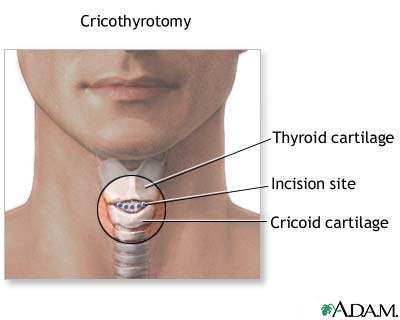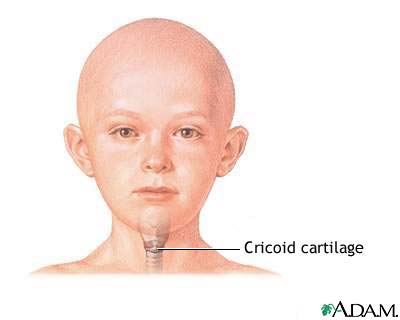Health Library
Emergency airway puncture
Needle cricothyrotomy
Emergency airway puncture is the placement of a hollow needle into the airway through the skin of the throat. It is done to treat life-threatening choking.
Images


Presentation

I Would Like to Learn About:
Description
Emergency airway puncture is done in an emergency situation, when someone is choking and all other efforts to assist with breathing have failed.
- A hollow needle or tube can be inserted into the throat, just below the Adam's apple (thyroid cartilage), into the airway. The needle passes through the skin then between the thyroid cartilage and the cricoid cartilage.
- In a hospital, before inserting the needle, a small cut may be made in the skin and the membrane between the thyroid and cricoid cartilages.
Why the Procedure Is Performed
A needle cricothyrotomy is an emergency procedure to relieve an airway obstruction until surgery can be done to place a breathing tube (tracheostomy or surgical cricothyrotomy).
If the airway blockage occurs with trauma to the head, neck, or spine, care must be taken to avoid further injury to the person.
Risks
Risks for this procedure include:
- Injury to the voice box (larynx), thyroid gland, or esophagus
Risks for any surgery are:
- Bleeding
- Infection
Outlook (Prognosis)
How well the person does depends on the cause of the airway blockage and how quickly the person receives proper breathing support. Emergency airway puncture provides enough breathing support for only a very short period of time.
Related Information
Abdominal thrustsBreathing difficulty
Tracheostomy
References
Cavallone LF, Cattano D, Piacentini AGG. Percutaneous emergency airway access. In: Hagberg C, ed. Hagberg and Benumof's Airway Management. 5th ed. Philadelphia, PA: Elsevier; 2023:chap 28.
Hebert RB, Thomas D. Cricothyrotomy and percutaneous translaryngeal ventilation. In: Roberts JR, Custalow CB, Thomsen TW, eds. Roberts and Hedges' Clinical Procedures in Emergency Medicine and Acute Care. 7th ed. Philadelphia, PA: Elsevier; 2019:chap 6.
BACK TO TOPReview Date: 10/6/2022
Reviewed By: Jesse Borke, MD, CPE, FAAEM, FACEP, Attending Physician at Kaiser Permanente, Orange County, CA. Also reviewed by David C. Dugdale, MD, Medical Director, Brenda Conaway, Editorial Director, and the A.D.A.M. Editorial team.
 | A.D.A.M., Inc. is accredited by URAC, for Health Content Provider (www.urac.org). URAC's accreditation program is an independent audit to verify that A.D.A.M. follows rigorous standards of quality and accountability. A.D.A.M. is among the first to achieve this important distinction for online health information and services. Learn more about A.D.A.M.'s editorial policy, editorial process and privacy policy. A.D.A.M. is also a founding member of Hi-Ethics. This site complies with the HONcode standard for trustworthy health information: verify here. |
The information provided herein should not be used during any medical emergency or for the diagnosis or treatment of any medical condition. A licensed medical professional should be consulted for diagnosis and treatment of any and all medical conditions. Links to other sites are provided for information only -- they do not constitute endorsements of those other sites. No warranty of any kind, either expressed or implied, is made as to the accuracy, reliability, timeliness, or correctness of any translations made by a third-party service of the information provided herein into any other language. © 1997- 2024 A.D.A.M., a business unit of Ebix, Inc. Any duplication or distribution of the information contained herein is strictly prohibited.
